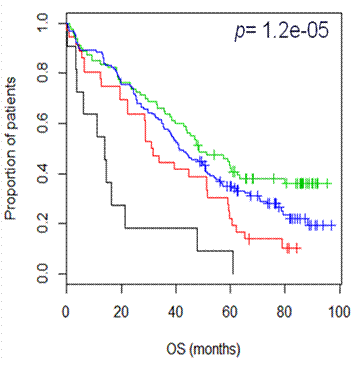Abstract
Glycosylation is a post translational modification which results in the addition of carbohydrate determinants to proteins and lipids. This has a major influence on the function of molecules known to be important in myeloma cell adhesion and trafficking such as integrins and selectins. We previously reported that ST3GAL6, a sialyltransferase involved in the synthesis of functional selectin ligands in humans, is over expressed in myeloma cells and associated with inferior survival in the MRC Myeloma IX study (MRC IX). We now extend our analysis of the MRC IX dataset to evaluate the potential prognostic significance of other glycosylation genes that are differentially regulated between normal and malignant plasma cells.
Analyzing publically available microarray transcriptomic datasets (Mayo Clinic GSE6477, University of Arkansas (UAMS) GSE24080, GSE2658) we first identified dysregulated glycosylation genes in MM. The prognostic significance of these candidate genes in MRCIX (singly and in combination) was analyzed using Kaplan Meier survival estimates for progression free survival and overall survival (PFS, OS). These results were validated in independent datasets (TT2 and TT3). Any genes significantly associated with survival were correlated with FISH abnormalities and ISS and multivariate analysis was performed to determine their independence as prognostic factors. QPCR was performed in cell lines to validate GEP findings. Matching SNP-based mapping array and methylation array data were analyzed. Membrane protein extracts from MM cell lines were applied directly to lectin microarrays following fluorescent labeling to generate cell surface glycan profiles. Immunohistochemistry for glycosylation enzymes and glycans was performed on patient bone marrow samples.
High expression (top quartile as cut-off) of the sialyltransferase gene ST3GAL1 showed a trend towards inferior OS (median survival 35 mos .v. 45 mos, p=0.07) with significantly reduced PFS (19 .v. 14 mos, p=0.015). Increased expression of ST3GAL1 correlated with the presence of t(4;14) (p=0.009), del13q (p=0.001), +1q (p=0.01) and hypodiploidy (p=0.00001). Low expression (lower quartile by GEP) of the gene FUCA1, which encodes tissue alpha-L-fucosidase, was linked to inferior outcome (median OS 44 .v. 38 mos, p=0.025). On multivariate analysis low FUCA1 expression was independent of other important prognostic factors (HR=1.61, p=0.017). Patients with t(11;14) by FISH were more likely to have low FUCA1 than t(11;14) negative patients. There was no significant association between ISS and ST3GAL6, ST3GAL1 or FUCA1. We verified the effect of low FUCA1 in the GSE24080 dataset from TT2 and TT3 combined. Patients with low FUCA1 had significantly worse OS (p=0.0002). SNP mapping array and methylation array analysis did not show any evidence of correlation between copy number alterations or hypermethylation of FUCA1 and its low expression level. Since FUCA1 participates in N-glycan degradation with removal of fucose residues, this raises the possibility that a reduction in FUCA1 may lead to excessive fucosylation of cancer related glycans involved in adhesion and trafficking, such as sLex. Indeed, lectin arrays of MM cell lines revealed high levels of a-1,3/a-1,6 linked fucose, as determined by binding of Aleuria Aurantia Lectin (AAL). The HECA-452 antibody recognizes a functional trisaccharide domain shared by sialyl Lewis a and sLex and known to bind to E-selectin. Preliminary immunohistochemistry revealed increased HECA452 staining in bone marrow samples, which had both strong ST3GAL6 and low FUCA1 staining. Combining gene expression data showed that reduced expression of FUCA1 with increased expression of either ST3GAL6 or ST3GAL1 or both, identified a subgroup of patients (18%) in MRC Myeloma IX with particularly poor outcome (figure 1). Similar results were found in TT2 and TT3 with 17% of patients affected.
MRC Myeloma IX: 4 distinct risk groups based on expression level of FUCA1, ST3GAL6 and ST3GAL1. Ultra high/high (black and red respectively) = 18% patients. Median OS high risk (black) = 13.9 mos. vs 48.3 low risk (green).
MRC Myeloma IX: 4 distinct risk groups based on expression level of FUCA1, ST3GAL6 and ST3GAL1. Ultra high/high (black and red respectively) = 18% patients. Median OS high risk (black) = 13.9 mos. vs 48.3 low risk (green).
Altered glycosylation gene expression patterns may identify patients at high risk of disease progression and early death. Our data implicates sialyltransferases and selectin ligands as potential therapeutic targets in MM.
Morgan:Celgene: Consultancy, Honoraria, Membership on an entity’s Board of Directors or advisory committees; Millenium: Consultancy, Honoraria, Membership on an entity’s Board of Directors or advisory committees; Novartis: Consultancy, Honoraria, Membership on an entity’s Board of Directors or advisory committees; Merck: Consultancy, Honoraria, Membership on an entity’s Board of Directors or advisory committees; Johnson and Johnson: Consultancy, Honoraria, Membership on an entity’s Board of Directors or advisory committees. Ghobrial:Onyx: Advisoryboard Other; BMS: Advisory board, Advisory board Other, Research Funding; Noxxon: Research Funding; Sanofi: Research Funding.
Author notes
Asterisk with author names denotes non-ASH members.


This feature is available to Subscribers Only
Sign In or Create an Account Close Modal